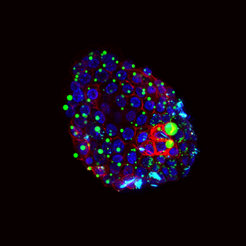Fat for better embryonic sleep
Scientists describe the role of lipid metabolism in fueling the phenomenon of embryonic diapause
In a new paper in Nature Cell Biology, Aydan Bulut-Karslioglu's team shows that embryos undergoing diapause rely on lipids as their main energy source. They also identified a key regulator of the energy balance in dormant embryos.

For many wild mammals, timing the birth of their offspring with favorable environmental conditions is critical to ensure reproductive success. Species such as kangaroos, bears, and rodents have evolved a strategy called embryonic diapause, in which they can halt embryonic development during challenges such as starvation until the environmental conditions improve. This state requires well-timed changes in genetic expression and also necessitates an adapted metabolism: "Dormant embryos must somehow reduce the supply of nutrients to stop growth, but at the same time maintain a steady source of energy to survive," explains Aydan Bulut-Karslioglu. As the scientists have now discovered, the nutrient that can provide this energy is fat. "The main finding of our study is that in dormant embryos metabolism is rewired to rely on lipids stored in cells as the main nutrient," says Aydan Bulut-Karslioglu.
Prolonging dormancy
The lab previously developed an in vitro system, based on the observation that inhibiting a key cellular signaling pathway called mTOR induces diapause in mouse embryos and stem cells. Knowing that lipids nourish dormant embryos, the scientists then fed various lipids and metabolites into their in vitro system. They discovered that a metabolite called L-carnitine, which helps cells use stored fat reserves, can have a practical side effect: "Supplementation with L-carnitine improved our in vitro system, prolonged the dormant state to a duration of up to 34 days, and also helped to put the embryos into a deeper yet reversible dormancy," says Aydan Bulut-Karslioglu. The team with first author Vera Van der Weijden also identified the Forkhead box protein O1 (FOXO1) as the main switch that regulates the metabolic changes and helps maintain dormancy.
Role of lipid metabolism in other dormant cells
The phenomenon of dormancy occurs not only in embryos but also in adult tissues, where dormant stem cells serve as a pool to replenish more specialized cells. The researchers compared their findings with existing datasets on the transcriptional activity of dormant adult cells. They found that FOXO1 and many other upregulated genes are involved in lipid metabolism, suggesting common underlying mechanisms between the two phenomena. The improved in vitro dormancy system created by the scientists could now facilitate further research on dormancy and has potential for biotechnological applications: "We have tweaked the system to make the embryos use their own lipids more efficiently. Our next goal is to find a way to supply the embryo with external lipids. This could allow us to maintain the in vitro dormant state even longer," says Aydan Bulut- Karslioglu.









![[2025] - Chromatin regulation in stem cells and development](/3855034/original-1696838420.jpg?t=eyJ3aWR0aCI6MzYwLCJoZWlnaHQiOjI0MCwiZml0IjoiY3JvcCIsImZpbGVfZXh0ZW5zaW9uIjoianBnIiwib2JqX2lkIjozODU1MDM0fQ%3D%3D--a2913c09d9456699bde795226d5ccaaa3483cf5b)


